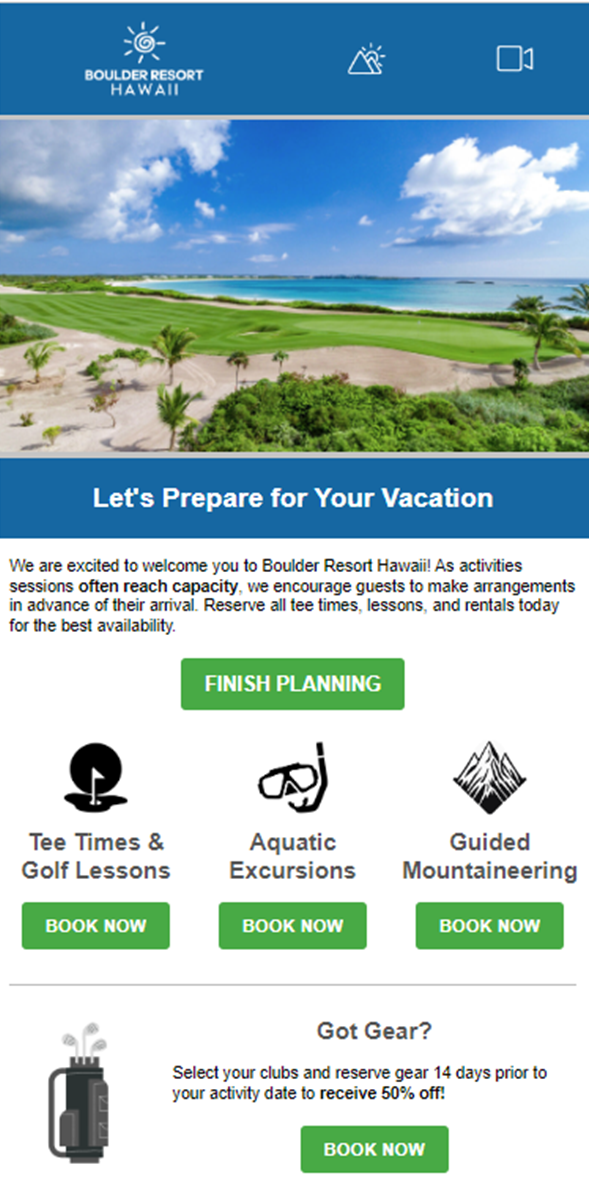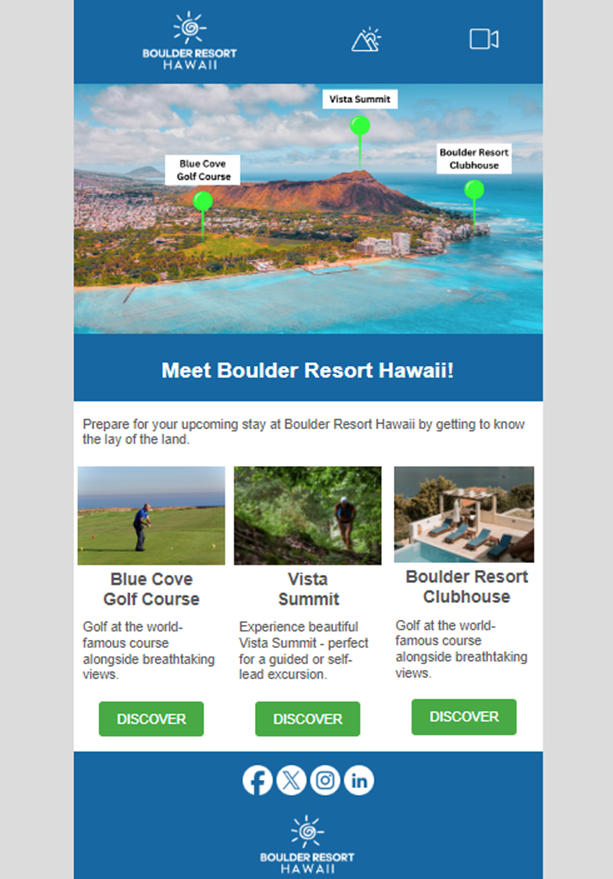Your guests' experience begins long before they arrive for their stay. Manage their expectations, increase on-site spend and get that 5-star review by establishing a strategic pre-arrival email series.
Reservation Trigger
When your customer books a room or property, we know that their upcoming visit is top of mind. Take advantage of their attention by connecting with your guest while they are in the planning mindset.
Audience
You can easily identify guests who have just completed a reservation by using the “Date Formula” in Audience Builder and setting the Reservation Date equal to “1 Day Before Today’s Date.” When guests’ transaction/reservation data enters the CDP, they will immediately receive your Reservation Trigger email.

Content
When strategizing content for Reservation Trigger email, it can be helpful to prioritize products that often sell out and use language that implies urgency to encourage customers to book in advance of their arrival. You can also educate guests on advanced purchase deadlines & discounts.
 An example of a reservation triggered email from golf resort, Boulder Resort Hawaii.
An example of a reservation triggered email from golf resort, Boulder Resort Hawaii.
Pre-Stay Touchpoint
Depending on the booking window for your property or resort, it makes sense to send another email to your guests between their reservation and arrival date. Take this as an opportunity to educate guests on what they can expect during their stay and to promote spend on advanced-purchase products. Use what you already know about guest behavior or analyze historical booking activity to determine the best cadence for your pre-stay touchpoint. For example, Boulder Resort Hawaii knows their guests typically book lodging 60+ days in advance of their arrival. With this larger booking window, it might make sense to send an email 30 days before the arrival date to remind guests of their upcoming vacation.
Audience
You can use the same field to target your Pre-Stay Touchpoint and set the cadence depending on your customers behavior and your preferences.

Content
Utilize the Pre-Stay Touchpoint to showcase additional services, ticketed events and extra activities to round out your guest’s itinerary. Depending on your customers’ typical booking window, it might make sense to have multiple Pre-Stay Touchpoints with different goals outside of revenue, such as engagement or education.
Engagement
User-generated-content and blog posts can be an effective way to engage guests in your email and increase engagement metrics.
 Example of a pre-stay touchpoint email from Boulder Resort Hawaii where the goal is to drive email engagement.
Example of a pre-stay touchpoint email from Boulder Resort Hawaii where the goal is to drive email engagement.
Education
Entice guests to click through to your website by offering up interesting information about your property. Send this email enough in advance of arrival so that time allows for additional products to be booked.
 Example of a pre-stay touchpoint email from Boulder Resort Hawaii where the goal is guest education.
Example of a pre-stay touchpoint email from Boulder Resort Hawaii where the goal is guest education.
Check-in Day/Welcome
Consider your guest 1-2 days prior to their arrival date – traveling to their destination and full of anticipation! A welcome email is the perfect place to direct guests to ancillary spend locations including dining, retail, and event venues near your destination. You can also include timely information that may be top of mind at this stage in the customer journey including check-in details, parking, or weather.
Audience
The audience for a welcome email can vary, but typically you will look for guests who are arriving to their lodging location in 1-2 days. You can use the “Arrival Date” field and “Enter Date Formula” to create an audience for a recurring email.

Content
Your welcome email is the 21st century version of the “in room guide” where you can maximize onsite spend by educating your guests on all the fun places they can dine, shop and recreate during their stay. Showcase lodging benefits to make your guest aware of amenities like guest discounts, onsite concierge, spa offerings and more.

Additional Segmentation
If the travel needs of your guests vary greatly, you might consider further audience segmentation to accommodate their differences.
- Destination guests
- These guests typically travel longer distances to your destination, consider their travel itinerary and when they are likely to be sitting at their airport or in a vehicle on their way, likely to check their email.
- Use geographic fields to identify guests that are traveling from out of state to your destination. For example, Boulder Resort Hawaii can target destination guests using the following audience:

- Drive Markets
- It may make sense to send a welcome email to drive market guests the day before or the day of their arrival, depending on what you know about the travel patterns of these guests and the typical duration of traveling by car, bus or train.
- For example, Boulder Resort Hawaii has high-speed shuttles and ferries that will take in-state guests to their destination and they can target these individuals using the following audience:




